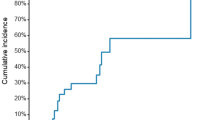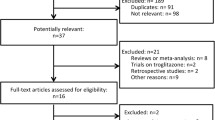Abstract
Objectives
Stent implantation produces a systemic increase of inflammatory markers that correlates with Chlamydophila pneumoniae infection in atherosclerotic plaque. We performed a clinical intervention study to investigate the effect of antibiotic treatment on 6-month follow-up angiographic minimal luminal diameter after stenting.
Methods
Ninety patients were randomly assigned to oral azithromycin or placebo in a double-blinded and randomized fashion. Medication was initiated 2 weeks before a pre-scheduled stenting procedure and maintained 12 weeks thereafter. Angiographic outcomes were evaluated by a six-month follow-up angiography and laboratorial parameters were accessed by blood sampling 2 weeks before stenting, within the first 24 h after procedure and additional samples after four weeks and 6 months.
Results
Minimal luminal diameter (1.76 ± 0.56 mm Vs. 1.70 ± 0.86 mm; P = 0.7), restenosis rate, diameter stenosis, late loss, and binary restenosis rates were comparable in placebo and azithromycin group in the 6 months follow-up. Serum levels of C-reactive protein presented a three fold significant increase in the control group one day after stenting but did not change in the azithromycin group (8.5 [3.0;16.4] Vs. 2.9 [1.7;6.6]–median [25;75 percentile] P < 0.01).
Conclusions
Azithromycin does not improve late angiographic outcomes but attenuates the elevation of C-reactive protein levels after stenting, indicating an anti-inflammatory effect.



Similar content being viewed by others
References
Azar RR, McKay RG, Kiernan FJ, Seecharran B, Feng YJ, Fram DB, Wu AH, Waters DD (1997) Coronary angioplasty induces a systemic inflammatory response. Am J Cardiol 80:1476–1478
Berk BC (2001) Vascular smooth muscle growth: autocrine growth mechanisms. Physiol Rev 81:999–1030
Blasi F, Boman J, Esposito G, Melissano G, Chiesa R, Cosentini R, Tarsia P, Tshomba Y, Betti M, Alessi M et al (1999) Chlamydia pneumoniae DNA detection in peripheral blood mononuclear cells is predictive of vascular infection. J Infect Dis 180:2074–2076
Boman J, Gaydos CA (2000) Polymerase chain reaction detection of chlamydia pneumoniae in circulating white blood cells. J Infect Dis 181(Suppl 3):S452–S454
Cook S, Walker A, Hugli O, Togni M, Meier B (2007) Percutaneous coronary interventions in Europe: prevalence, numerical estimates, and projections based on data up to 2004. Clin Res Cardiol 96:375–382
Dusek J, St’asek J, Tichy M, Bis J, Gregor J, Vojacek J, Masin V, Polansky P, Brtko M, Cernohorsky D (2006) Prognostic significance of ischemia modified albumin after percutaneous coronary intervention. Clin Chim Acta 367:77–80
Gomes WJ, Buffolo E (2006) Coronary stenting and inflammation: implications for further surgical and medical treatment. Ann Thorac Surg 81:1918–1925
Herdeg C, Gohring-Frischholz K, Helber U, Geisler T, May A, Haase KK, Gawaz M (2008) Successful local antiproliferative paclitaxel delivery in a repeatedly restenosed lesion of the right coronary artery after drug eluting-stent implantation. Clin Res Cardiol 97:49–52
Higuchi ML, Sambiase N, Palomino S, Gutierrez P, Demarchi LM, Aiello VD, Ramires JA (2000) Detection of mycoplasma pneumoniae and chlamydia pneumoniae in ruptured atherosclerotic plaques. Braz J Med Biol Res 33:1023–1026
Hojo Y, Ikeda U, Katsuki T, Mizuno O, Fukazawa H, Kurosaki K, Fujikawa H, Shimada K (2000) Interleukin 6 expression in coronary circulation after coronary angioplasty as a risk factor for restenosis. Heart 84:83–87
Kuo C, Campbell LA (2000) Detection of chlamydia pneumoniae in arterial tissues. J Infect Dis 181(Suppl 3):S432–S436
Latsios G, Saetta A, Michalopoulos NV, Agapitos E, Patsouris E (2004) Detection of cytomegalovirus, helicobacter pylori and chlamydia pneumoniae DNA in carotid atherosclerotic plaques by the polymerase chain reaction. Acta Cardiol 59:652–657
Lemos PA, Mercado N, van Domburg RT, Kuntz RE, O’Neill WW, Serruys PW (2004) Comparison of late luminal loss response pattern after sirolimus-eluting stent implantation or conventional stenting. Circulation 110:3199–3205
McBride W, Lange RA, Hillis LD (1988) Restenosis after successful coronary angioplasty: pathophysiology and prevention. N Engl J Med 318:1734–1737
Mollmann H, Elsasser A, Nef H, Schneider S, Nienaber CA, Richardt G, Weber M, Kelm M, Levenson B, Bonzel T et al (2008) Treatment of in-stent restenosis with sirolimus-eluting-stents: results from the prospective German Cypher stent registry. Clin Res Cardiol 97(7):432–440
Morrow DA, Cannon CP, Jesse RL, Newby LK, Ravkilde J, Storrow AB, Wu AH, Christenson RH (2007) National academy of clinical biochemistry laboratory medicine practice guidelines: clinical characteristics and utilization of biochemical markers in acute coronary syndromes. Circulation 115:e356–e375
Neumann F, Kastrati A, Miethke T, Pogatsa-Murray G, Mehilli J, Valina C, Jogethaei N, da Costa CP, Wagner H, Schomig A (2001) Treatment of chlamydia pneumoniae infection with roxithromycin and effect on neointima proliferation after coronary stent placement (ISAR-3): a randomised, double-blind, placebo-controlled trial. Lancet 357:2085–2089
Ong, AT, van Domburg RT, Aoki J, Sonnenschein K, Lemos PA, Serruys PW (2006) Sirolimus-eluting stents remain superior to bare-metal stents at two years: medium-term results from the rapamycin-eluting stent evaluated at Rotterdam Cardiology Hospital (RESEARCH) registry. J Am Coll Cardiol 47:1356–1360
Radke PW, Jain D, Conrad A, Thomsen C, Remmel M, Kurowski V, Schunkert H, Hartmann F (2008) Evaluation of the dedicated Frontiertrade mark coronary bifurcation stent: a matched pair analysis with drug-eluting and bare metal stents. Clin Res Cardiol 97:260–265
Reiber JH, Serruys PW, Kooijman CJ, Wijns W, Slager CJ, Gerbrands JJ, Schuurbiers JC, den Boer A, Hugenholtz PG (1985) Assessment of short-, medium-, and long-term variations in arterial dimensions from computer-assisted quantitation of coronary cineangiograms. Circulation 71:280–288
Scheller B, Kuhler M, Cremers B, Mahnkopf D, Bohm M, Boxberger M (2008) Short- and long-term effects of a novel paclitaxel coated stent in the porcine coronary model. Clin Res Cardiol 97:118–123
Schwartz RS, Murphy JG, Edwards WD, Camrud AR, Vliestra RE, Holmes DR (1990) Restenosis after balloon angioplasty: a practical proliferative model in porcine coronary arteries. Circulation 82:2190–2200
Serruys PW, van Hout B, Bonnier H, Legrand V, Garcia E, Macaya C, Sousa E, van der Giessen W, Colombo A, Seabra-Gomes R et al (1998) Randomised comparison of implantation of heparin-coated stents with balloon angioplasty in selected patients with coronary artery disease (Benestent II). Lancet 352:673–681
Smith SC, Jr, Blair SN, Bonow RO, Brass LM, Cerqueira MD, Dracup K, Fuster V, Gotto A, Grundy SM, Miller NH et al (2001) AHA/ACC guidelines for preventing heart attack and death in patients with atherosclerotic cardiovascular disease: 2001 update. A statement for healthcare professionals from the American Heart Association and the American College of Cardiology. J Am Coll Cardiol 38:1581–1583
Stone GW, Ellis SG, Cox DA, Hermiller J, O’Shaughnessy C, Mann JT, Turco M, Caputo R, Bergin P, Greenberg J et al (2004) One-year clinical results with the slow-release, polymer-based, paclitaxel-eluting TAXUS stent: the TAXUS-IV trial. Circulation 109:1942–1947
Tiran A, Tio RA, Ossewaarde JM, Tiran B, den Heijer P, The TH, Wilders-Truschnig MM (1999) Coronary angioplasty induces rise in chlamydia pneumoniae-specific antibodies. J Clin Microbiol 37:1013–1017
Tiran A, Tiesenhausen K, Karpf E, Orfila J, Koch G, Gruber HJ, Tsybrovskyy O, Tiran B (2004) Association of antibodies to chlamydial lipopolysaccharide with the endovascular presence of Chlamydophila pneumoniae in carotid artery disease. Atherosclerosis 173:47–54
Walter DH, Fichtlscherer S, Sellwig M, Auch-Schwelk W, Schachinger V, Zeiher AM (2001) Preprocedural C-reactive protein levels and cardiovascular events after coronary stent implantation. J Am Coll Cardiol 37:839–846
Yetkin G, Yetkin E, Aksoy Y, Gurbuz OA, Mert A (2004) Changes in antibody titers against chlamydia pneumoniae after coronary angioplasty. Int J Cardiol 95:293–297
Competing interest statement
The authors and co-authors declare no competing interest.
Author information
Authors and Affiliations
Corresponding author
Rights and permissions
About this article
Cite this article
Ikeoka, D.T., Vieira, C.Z., Lemos, P.A. et al. Azithromycin does not prevent six-month myointimal proliferation but attenuates the transient systemic inflammation occurring after coronary stenting. Clin Res Cardiol 98, 44–51 (2009). https://doi.org/10.1007/s00392-008-0722-1
Received:
Accepted:
Published:
Issue Date:
DOI: https://doi.org/10.1007/s00392-008-0722-1




